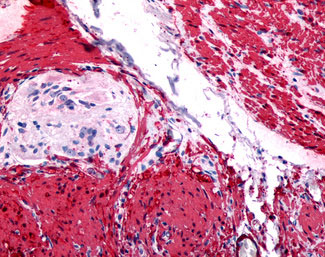GRPR Antibody (Center)
Product Code: #MBT9970c
Packaging: 50 µl
Base price 1100 元
Sales price 1100 元
Discount
Price / kg:
Description
Product Information
| Application
|
WB, IHC-P, FC, E |
| Primary Accession |
P30550 |
| Other Accession |
P52500, P21729 |
| Reactivity |
Human, Rat, Mouse |
| Predicted |
Mouse, Rat |
| Host |
Rabbit |
| Clonality |
Polyclonal |
| Isotype |
Rabbit IgG |
| Calculated MW |
43199 Da |
| Antigen Region |
123-152 aa |
Additional Information
| Gene ID |
2925 |
| Other Names |
Gastrin-releasing peptide receptor, GRP-R, GRP-preferring bombesin receptor, GRPR |
| Target/Specificity |
This GRPR antibody is generated from rabbits immunized with a KLH conjugated synthetic peptide between 123-152 amino acids from the Central region of human GRPR. |
| Dilution |
WB~~1:1000 |
| Format |
Purified polyclonal antibody supplied in PBS with 0.05% (V/V) Proclin 300. This antibody is prepared by Saturated Ammonium Sulfate (SAS) precipitation followed by dialysis against PBS. |
| Storage |
Maintain refrigerated at 2-8°C for up to 2 weeks. For long term storage store at -20°C in small aliquots to prevent freeze-thaw cycles. |
| Precautions |
GRPR Antibody (Center) is for research use only and not for use in diagnostic or therapeutic procedures. |
Protein Information
| Name |
GRPR |
| Function |
Receptor for gastrin-releasing peptide (GRP) (PubMed:1655761). Signals via association with G proteins that activate a phosphatidylinositol-calcium second messenger system, resulting in Akt phosphorylation. Contributes to the regulation of food intake. Contributes to the perception of prurient stimuli and transmission of itch signals in the spinal cord that promote scratching behavior, but does not play a role in the perception of pain. Contributes primarily to nonhistaminergic itch sensation. In one study, shown to act in the amygdala as part of an inhibitory network which inhibits memory specifically related to learned fear (By similarity). In another study, shown to contribute to disinhibition of glutamatergic cells in the auditory cortex via signaling on vasoactive intestinal peptide- expressing cells which leads to enhanced auditory fear memories (By similarity). Contributes to the induction of sighing through signaling in the pre-Botzinger complex, a cluster of several thousand neurons in the ventrolateral medulla responsible for inspiration during respiratory activity (By similarity). |
| Cellular Location |
Cell membrane; Multi-pass membrane protein |
| Tissue Location |
Highly expressed in pancreas (PubMed:11245983). Also expressed in stomach, adrenal cortex and brain (PubMed:11245983) In brain, expressed in cells throughout the cortex (PubMed:34610277) |
Reviews
There are yet no reviews for this product.
